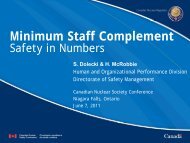Investigation of the Environmental Fate of Tritium in the Atmosphere
Investigation of the Environmental Fate of Tritium in the Atmosphere
Investigation of the Environmental Fate of Tritium in the Atmosphere
Create successful ePaper yourself
Turn your PDF publications into a flip-book with our unique Google optimized e-Paper software.
3.3.5 Next Generation Dispersion Models<br />
INVESTIGATION OF THE ENVIRONMENTAL FATE OF TRITIUM IN THE ATMOSPHERE<br />
The US EPA (2003) conducted a comprehensive assessment <strong>of</strong> <strong>the</strong> differences between<br />
earlier dispersion models (i.e., ISC) with newer generation models such as AERMOD.<br />
S<strong>in</strong>ce <strong>the</strong> model <strong>of</strong>ten used to predict contam<strong>in</strong>ant concentrations at Canadian nuclear<br />
facilities is similar to ISC, <strong>the</strong> f<strong>in</strong>d<strong>in</strong>gs <strong>of</strong> this assessment can be used to provide some<br />
general comments regard<strong>in</strong>g <strong>the</strong> differences between ISC-like models and more advanced<br />
regulatory models like AERMOD. The US EPA (2003) found that relative to ISCST3,<br />
AERMOD currently conta<strong>in</strong>s new or improved algorithms for:<br />
• Dispersion <strong>in</strong> both <strong>the</strong> convective and stable boundary layers;<br />
• Dry and wet depositions;<br />
• Plume rise and buoyancy;<br />
• Plume penetration <strong>in</strong>to elevated <strong>in</strong>versions;<br />
• Treatment <strong>of</strong> elevated, near-surface, and surface level sources;<br />
• Computation <strong>of</strong> vertical pr<strong>of</strong>iles <strong>of</strong> w<strong>in</strong>d, turbulence, and temperature; and,<br />
• ‘Cont<strong>in</strong>uous’ treatment <strong>of</strong> receptors on all types <strong>of</strong> terra<strong>in</strong> from <strong>the</strong> surface up to and<br />
above <strong>the</strong> plume height (i.e., simple, <strong>in</strong>termediate, and complex terra<strong>in</strong>).<br />
For non-downwash sett<strong>in</strong>gs <strong>in</strong> flat and simple terra<strong>in</strong>, AERMOD tends to predict maximum<br />
concentrations that are similar to ISC. Where build<strong>in</strong>g downwash is a significant factor <strong>in</strong><br />
<strong>the</strong> air dispersion analysis, AERMOD aga<strong>in</strong> predicts maximum concentrations and maximum<br />
cavity concentrations that are very similar to ISC. More significant differences between <strong>the</strong><br />
two models occur when deal<strong>in</strong>g with dispersion around hills. AERMOD tends to produce<br />
much lower maximum concentrations than <strong>the</strong> screen<strong>in</strong>g technique <strong>in</strong> ISC. Overall, <strong>the</strong> US<br />
EPA (2003) concluded that AERMOD outperforms ISC (-ST3 and –PRIME).<br />
3.4 Impact <strong>of</strong> Climate Change on <strong>Tritium</strong> Dispersion<br />
In recent years, <strong>the</strong>re has been <strong>in</strong>creased <strong>in</strong>terest <strong>in</strong> understand<strong>in</strong>g <strong>the</strong> <strong>in</strong>fluence <strong>of</strong> climate<br />
change on wea<strong>the</strong>r patterns, atmospheric chemistry processes and future air quality. Studies<br />
<strong>in</strong>dicate that cont<strong>in</strong>ued Green House Gas (GHG) emissions at or above current rates would<br />
cause fur<strong>the</strong>r warm<strong>in</strong>g and <strong>in</strong>duce many changes <strong>in</strong> <strong>the</strong> global climate system dur<strong>in</strong>g <strong>the</strong> 21st<br />
century that would very likely be larger than those observed dur<strong>in</strong>g <strong>the</strong> 20th century (IPCC,<br />
2007, MacCracken, 2008). These factors have <strong>the</strong> potential to <strong>in</strong>fluence <strong>the</strong> atmospheric<br />
dispersion <strong>of</strong> radionuclides released from nuclear facilities.<br />
There is now higher confidence <strong>in</strong> projected patterns <strong>of</strong> warm<strong>in</strong>g and o<strong>the</strong>r regional-scale<br />
features, <strong>in</strong>clud<strong>in</strong>g changes <strong>in</strong> w<strong>in</strong>d patterns, precipitation and some aspects <strong>of</strong> extreme<br />
wea<strong>the</strong>r. Factors such as changes <strong>in</strong> precipitation, absolute humidity <strong>in</strong> <strong>the</strong> air and soil<br />
moisture content will be particularly important for tritium behaviour <strong>in</strong> <strong>the</strong> atmosphere<br />
s<strong>in</strong>ce partition<strong>in</strong>g from air to surface water or soil water depend on <strong>the</strong>se parameters.<br />
Accord<strong>in</strong>g to <strong>the</strong> IPCC (2007), future climate change projections us<strong>in</strong>g multi-model<br />
ensembles show <strong>in</strong>creases <strong>in</strong> globally averaged mean water vapour, evaporation and<br />
precipitation. Of importance to Canada, <strong>the</strong> models suggest that precipitation will be<br />
BACK TO TABLE OF CONTENTS 42



